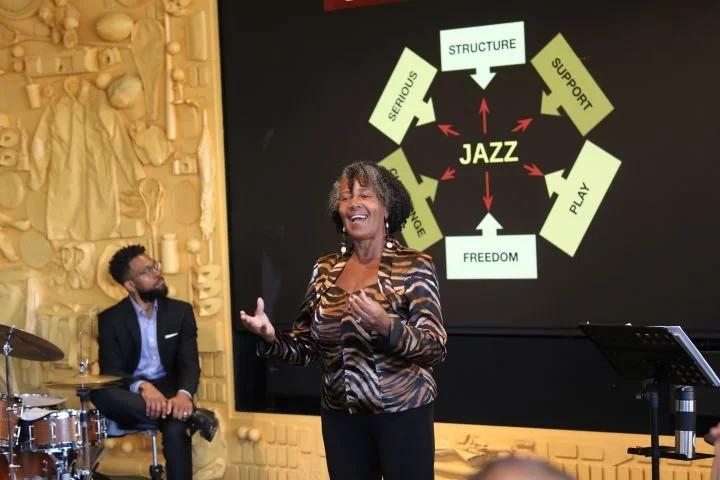Polarity Cadences Igniting Innovation
Thomas Edison’s Menlo Park inventors
A recent CBS Sunday Morning segment asked why the United States has produced more innovations that any other nation on earth—electricity, the airplane, the computer, the internet, air conditioning, the iPhone, and many more.
Steven Johnson, author of fourteen books on innovation, said that the archetype of a lone genius coming up with a novel discovery in a moment of sudden inspiration is not typically the way it happens. Case in point: The segment highlighted Thomas Edison’s plethora of innovations—the light bulb, motion pictures, the phonograph, as well as his philosophy of fostering innovation. Edison’s Menlo Park in New Jersey was a space to bring interesting people together to create an “invention factory” for new ideas. In other words, he had a collaborative systems approach to innovation.
That brings me to the art of jazz—a U.S. cultural innovation that has captivated people and influenced musical styles around the world. Formed from a blending of the blues, European harmonies, and African rhythms, jazz is characterized by complex chords, improvisation, and call and response. Jazz brought us the iconic talents and musical innovations of Louis Armstrong, Duke Ellington, Sarah Vaughan, Miles Davis, John Coltrane, Ella Fitzgerald, and too many others to mention here.
One of the reasons why jazz music, as well as our Jazz Leadership Project model, are extraordinary innovations are the foundation of dynamic polarities— contrasting elements that create productive tension and drive innovation. Jazz musicians learn to navigate between seemingly opposing forces, using the creative friction to generate breakthrough performances.
Success comes not from choosing a side, but from developing the sophistication to elegantly navigate between the polarities.
The Sophistication of Polarity Cadences
Individual Excellence and Collective Harmony: In Jazz, there is a beautiful balance between showcasing individual virtuosity while serving the ensemble's collective musical vision. Individual Excellence is showcased through solo performances, personal musical voice, and technical mastery. Collective harmony shines through ensemble coordination, musical conversation, and shared rhythmic pulse. Dynamic interaction happens when soloists take center stage while remaining connected to the ensemble's flow. Great jazz ensembles feature individuals who shine brightest when elevating the group performance.
Structure and Freedom: The foundational structure of jazz is framed in harmonic and song forms, and rhythmic swing. Often one or two instrumentalists lay down a consistent rhythmic groove as a foundation for the improvisational exploration of another. Such a structural device grounds agency so artists make their freestyle aesthetic statements on a secure foundation.
Serious and Playful: A fundamental operational methodology in the music and JLP is “serious play.” For musicians, attaining mastery is grounded in thousands of hours of serious practice. When they hit the stage, a spirit of play suffuses their performance, allowing improvisational innovation to blossom from that serious study.
Challenge and Support: The interplay of Antagonistic Cooperation transforms challenge and competition into opportunities for growth, learning, and development. It becomes a pivot point for deep, soulful listening to advance understanding and create shared responsibility.
Polarities Drive Performance through:
1. Creative Tension: Rather than resolving polarities, jazz and high-performing teams maintain dynamic tension between opposing elements, using this energy to drive innovation and excellence.
2. Contextual Navigation: Effective leaders and musicians learn to read situations and adjust their position between polarities based on current needs and opportunities.
3. Both/And Thinking: Instead of either/or choices, jazz leadership embraces both/and approaches that honor the value in opposing perspectives and approaches.
4. Emergence: The interaction between polarities creates emergent properties—breakthrough performances, innovative solutions, and collaborative excellence—that neither pole could achieve alone.
Consider Some Practical Applications for Leaders:
Cultivate both deep listening skills and authentic voice
Learn to manage creative tension without forcing premature resolution
Develop both analytical and intuitive decision-making capabilities
Balance directive leadership with shared leadership approaches
The mastery lies in playing with the polarities, using their dynamic interaction to create the kind of "swingin' harmony" that characterizes both great jazz and exceptional organizational performance. Like excellent jazz musicians who create their most innovative performances in the space between structure and freedom, being serious and playful, while presenting challenge and support, high-performing ensembles and organizations can thrive in the productive tension between complex, seemingly contradictory elements.



